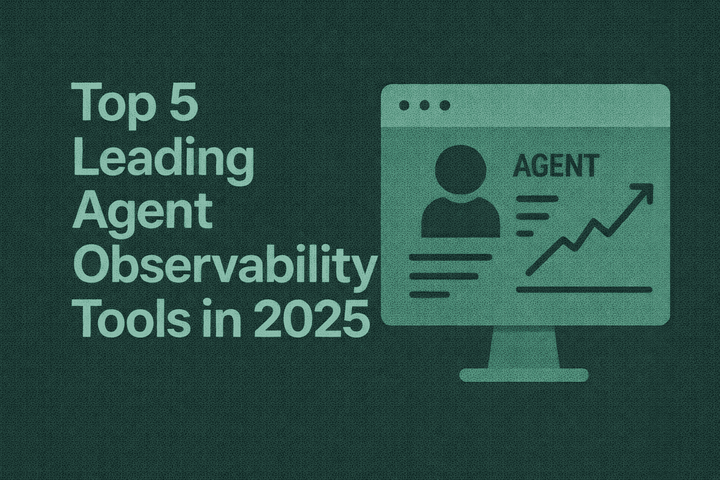10 Reasons Observability Is the Backbone of Reliable AI Systems
Discover why observability is the backbone of reliable AI systems: trace, measure, and improve agents with evidence, not guesswork.

TL;DR
Observability transforms AI agents from black boxes into measurable, improvable systems. By tracing every step, measuring quality continuously, and closing the loop from production to improvement, teams turn live traffic into better prompts, safer outputs, and higher success rates. This article outlines ten reasons observability matters for production AI, from localizing failures to specific nodes to governing with auditable evidence. If you're building AI at scale, observability is how you replace guesswork with evidence.
What Observability Is and Why It Matters
Observability is how teams see what their AI agents did, measure whether those actions were good, and turn those insights into steady, measurable improvements. In production, AI applications behave like multi-step workflows with prompts, retrievals, tool calls, and branching logic. Traditional server dashboards can't explain why a chatbot missed context or why an agent chose the wrong tool.
This approach spans distributed tracing, online evaluations, human-in-the-loop workflows, and quality alerts integrated with incident response tools. Below are ten reasons observability is the backbone of reliable AI systems, with a focus on production realities, enterprise relevance, and what changes when you measure quality continuously.
1) You can trace every step an agent takes
Agent workflows are not single model calls. They're multi-step processes that include planning, retrieval, tool calls, and response generation. Agent tracing (a trace is the end-to-end flow; a span is a single step) makes those decisions visible so engineers can replay sessions, inspect inputs and outputs, and pinpoint the step that caused an error.
Distributed tracing aligned to OpenTelemetry conventions helps standardize what gets captured across services, while a visual timeline keeps branching logic easy to navigate. This "see everything" capability is the foundation of agent observability and enables replay, inspection, and root cause analysis at scale.
2) You can measure quality continuously, not just latency
Traditional monitoring focuses on latency, throughput, and errors. AI systems also need quality signals: task success (did the agent actually complete the user's goal), faithfulness (does the answer align with retrieved context), and safety (does the output follow policy).
Online evaluations are automated checks that score real production interactions at session, trace, and span levels, then attach those scores to the same traces engineers use to debug. This lets teams detect regressions quickly and respond before users feel the impact. Evaluator design patterns and practical implementation guidance enable teams to instrument these quality signals systematically.
3) You can align evaluation with real agent behavior
LLM-as-a-judge means using a model to grade another model's outputs against rubrics, which is useful when deterministic checks are insufficient. This approach works well when rubrics are clear and calibrated, and it complements rule-based checks for format validity or structured outputs.
Crucially, these evaluations should match agent behavior, not just single-turn answers. They capture trajectory-level decisions like tool selection and plan adherence. Rubric design and calibration strategies for LLM-as-a-judge in agentic applications address where this approach fits and how to write tight evaluation criteria.
4) You can localize failures to specific nodes
Failure diagnosis becomes precise when you measure at the right layer. Session-level metrics show whether user goals were met. Span-level metrics flag specific steps: retrieval relevance (is the context useful), tool selection accuracy (did the agent choose the right tool with correct parameters), and parsing correctness (did it produce valid JSON).
Localizing problems this way helps teams fix root causes instead of patching symptoms. Engineers can re-run simulations at the failing step to reproduce issues deterministically and validate fixes before release.
5) You can close the loop from production to improvement
Observability is most powerful when it feeds evaluation and data curation. Production logs provide real examples of success and failure. Online evaluators score those examples. Human reviewers adjudicate the ambiguous ones. Teams then promote reviewed cases into golden datasets for offline regression testing and prompt improvements.
Closing this loop turns live traffic into continuously evolving test suites, which directly raises reliability over time. Wiring evaluations to traces and converting reviewed sessions into datasets creates this continuous feedback mechanism.
6) You can ship safely with pre-release and post-release checks
Offline evaluations test candidate prompts, workflows, and model choices against stable suites before deployment. Online evaluations catch drift and emerging edge cases after deployment. Both are necessary.
A practical cadence is: run offline suites in CI for each change, shadow test on a subset of traffic, then ramp evaluated sampling in production with rollback triggers tied to evaluator thresholds. This workflow puts quality gates around change without slowing iteration, aligning with evaluation best practices for agentic systems.
7) You can connect quality signals to alerts that matter
Alert fatigue is real. With AI workloads, alerts should focus on user-impacting signals: success rate drops on critical tasks, faithfulness below threshold for RAG responses, spike in tool-call failures, and cost per resolved task exceeding budget.
Because evaluators score the same traces you monitor for latency and errors, alerts can include deep links to the exact failing span and its input/output. This keeps incidents actionable and reduces mean time to resolution through operational alerting patterns that connect quality signals directly to remediation workflows.
8) You can quantify cost and performance alongside quality
AI costs arise from tokens and external API calls. Observability lets you correlate cost to quality: identify low-utility steps (steps that do not advance the task), detect loops that inflate latency, and prune unnecessary tool calls.
Teams track cost per resolved task, tokens per span, and p95 latency at each step. When combined with success and faithfulness scores, these metrics surface high-impact optimizations that maintain reliability while reducing spend. Tracking these trade-offs requires instrumentation at each span and aggregation across sessions to surface optimization opportunities.
9) You can govern with traceable, auditable evidence
Reliable AI systems need traceable lineage: where the data came from, which prompt version was used, what model parameters were set, and which evaluators scored the outputs. Governance means making this evidence auditable and consistent across environments.
Observability, evaluation, and human review form a transparent quality record that supports internal policies and external standards. Trace payloads, evaluator configuration, and dataset versioning establish this transparent quality record across environments.
10) You can scale collaboration across engineering and product
AI quality is a cross-functional responsibility. Engineers need detailed traces and tests. Product managers need success rates, cost per resolution, and user feedback trends. Observability surfaces both views from a single source of truth.
Evaluators and dashboards provide shared metrics so teams align on gates and priorities. This alignment reduces guesswork and accelerates iteration while preserving reliability through shared observability workflows that serve both engineering and product needs.
Closing the feedback loop: how evaluation metrics reduce AI agent failures in production
The core idea is simple: a handful of metrics highlight real issues, and those signals guide continuous improvement.
Task success means "did the agent accomplish the user's goal" with constraints respected. Teams chart success by prompt version, model, and persona to guide releases. When success dips, the trace shows exactly where the path broke, such as an incorrect tool choice or a retrieval miss.
Faithfulness means "the answer matches the retrieved context." In RAG flows, claims should align with documents. Low faithfulness often points to weak retrieval relevance or prompts that do not constrain synthesis tightly enough.
Step completion means "the agent followed the expected plan." Strict match checks the exact order; unordered match allows flexible execution. Failures here expose missing validations, skipped confirmations, or out-of-sequence actions.
Tool selection accuracy means "the agent used the right tool with the right arguments at the right time." Errors here cause retries, latency spikes, and cascaded failures.
Toxicity and policy checks mean "the response meets tone and safety requirements." These are quality gates, not afterthoughts.
A practical loop looks like this:
- Instrument traces and attach evaluators to production logs at session, trace, and span levels, balanced with sampling to control cost.
- Route low-scoring sessions to human review with concise rubrics for the last mile.
- Curate reviewed examples into golden datasets and scheduled offline regressions for each new prompt or model change.
- Compare deltas across versions in dashboards; prioritize fixes that raise success without hurting faithfulness or latency.
- Re-run targeted simulations from failure steps to validate improvements before full rollout.
LLM-as-a-judge evaluators fit when you need nuanced grading, like assessing relevance or tone, and they should be complemented with deterministic checks for structure and constraints. Rubric design, grader calibration, and stability considerations help teams keep LLM-as-a-judge scoring trustworthy. Observability patterns and SDK integration provide the scaffolding to capture telemetry, wire evaluations, and operationalize alerts across environments.
The result is a disciplined loop where every week of production makes the agent better: fewer loops, faster resolutions, stronger grounding, and higher user satisfaction. This is observability in service of reliability, and it's why quality programs that combine tracing, evaluation, and human review consistently outperform ad hoc testing. For teams building AI applications at scale, this approach turns "vibes" into verifiable progress and replaces guesswork with evidence.
Frequently Asked Questions
Which metrics matter most in production?
Start with a small bundle: Task Success (did it achieve the goal), Faithfulness (is the output grounded), Context Relevance (is retrieval useful), Tool Selection (right tool + arguments), and Toxicity (safety). Track them per span/trace/session and correlate with latency and cost.
How do online and offline evaluations work together?
Offline evaluations gate releases (CI, staging). Online evaluations score real traffic and catch regressions, drift, and edge cases post-deployment. Use online signals to route human review, open tickets, and curate datasets for the next offline run.
Where do traces help the most?
Traces localize failures. They show which step broke (e.g., wrong tool, weak retrieval, out-of-sequence action), with inputs/outputs and model parameters, so engineers can reproduce the issue and validate fixes quickly.
What alerts should we set?
Alert on user-impacting signals: drops in task success, low faithfulness for RAG answers, spikes in tool failures, cost per resolved task, and tail latency. Link alerts to the exact failing trace/span for fast triage.
What's the fastest way to start?
Instrument tracing in the orchestration layer, turn on a small evaluation bundle (Task Success, Faithfulness, Context Relevance, Toxicity, Tool Selection), and route low scores to human review. Ship with offline gates; monitor with online scoring; iterate weekly on the top failure clusters.
For teams formalizing AI quality, agent reliability topics, implementation patterns, and rubric guidance for agentic systems provide the foundation to operationalize these practices.
Ready to operationalize observability and evaluations for your agents? Request a demo or start a free trial.


